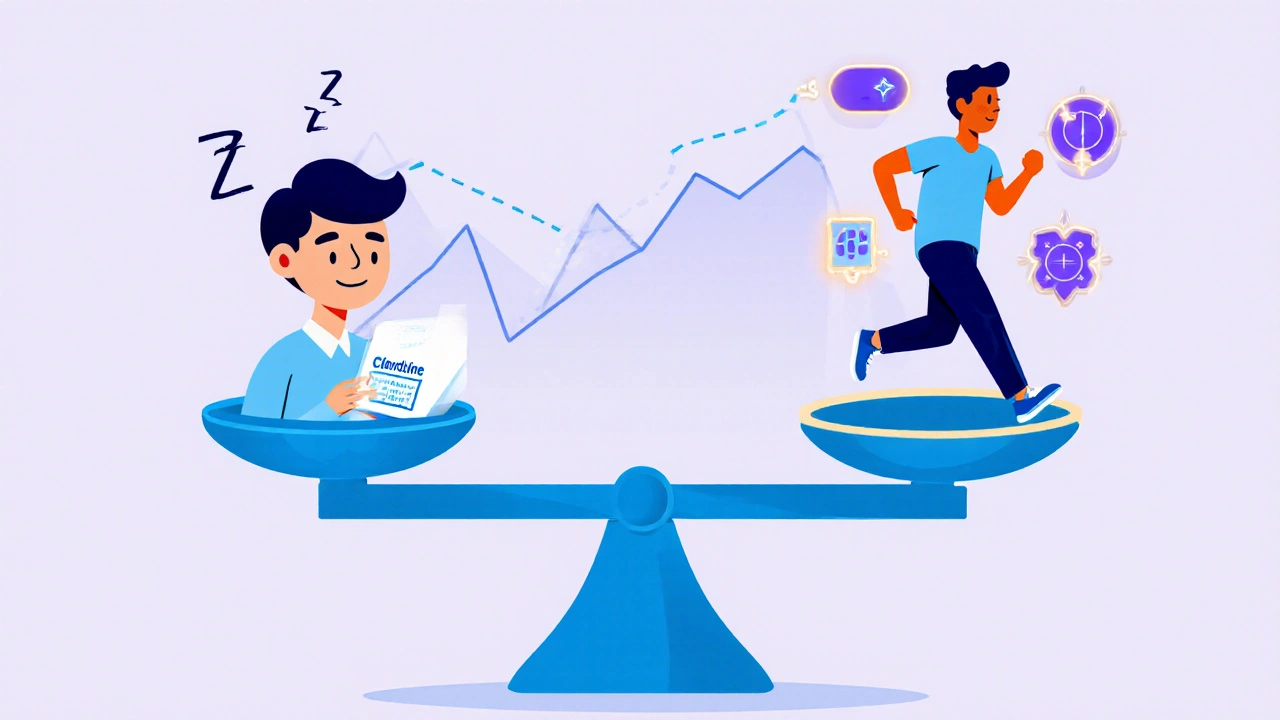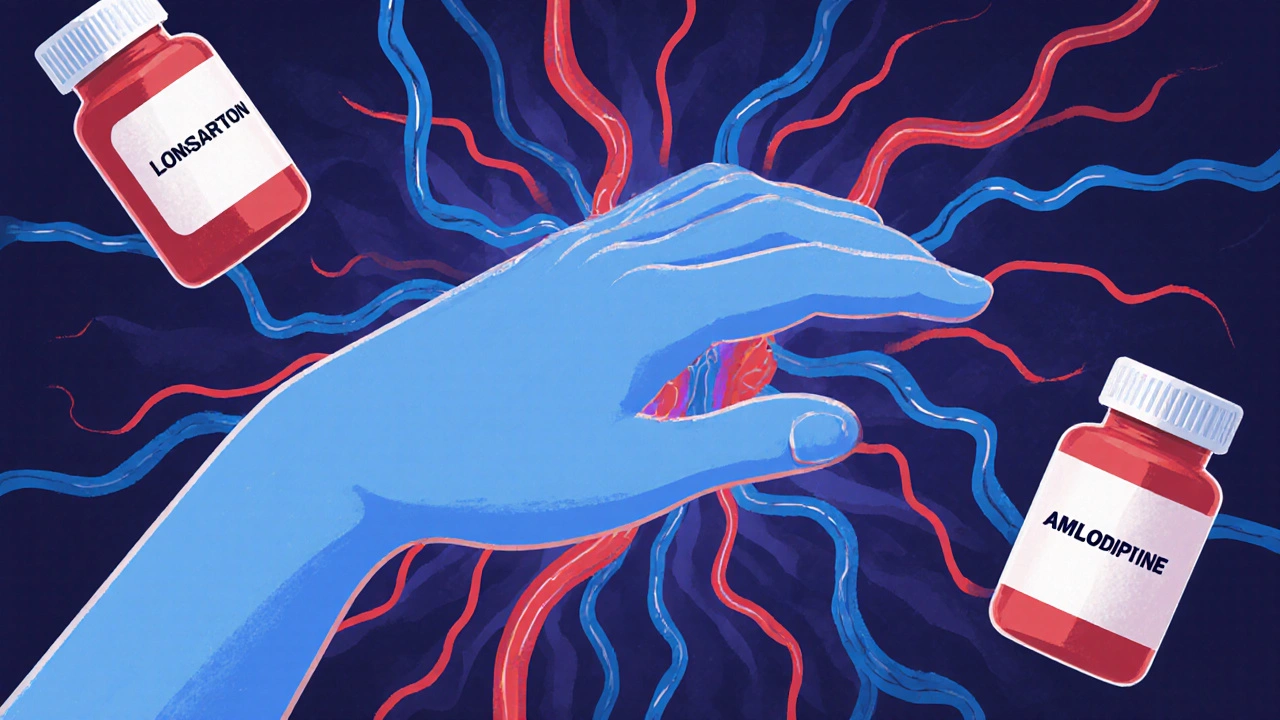Medication Comparison Tool
Compare Medications
Clonidine isn’t the first drug most people think of for high blood pressure or ADHD, but it’s been used for decades - and for good reason. It works differently than most others, which makes it useful in specific cases. But if you’re taking it and wondering if there’s something better, safer, or more effective, you’re not alone. Many patients and doctors look at clonidine alternatives when side effects pile up, when it stops working, or when a simpler option is needed.
What Clonidine Actually Does
Clonidine is a central alpha-2 agonist. That’s a fancy way of saying it calms down your nervous system by acting on receptors in your brainstem. This reduces nerve signals that tell your heart to beat faster and your blood vessels to tighten. The result? Lower blood pressure. It’s also used off-label for ADHD because it helps reduce impulsivity and hyperactivity by calming overactive brain pathways.
Clonidine comes in pills, patches, and sometimes liquid form. The patch (Catapres TTS) delivers a steady dose over 7 days, which helps avoid the spikes and drops you get with pills. But it’s not perfect. Common side effects include drowsiness, dry mouth, dizziness, and low blood pressure - especially when standing up. Some people report withdrawal symptoms if they stop suddenly, including rebound high blood pressure and anxiety.
Why People Look for Alternatives
People switch from clonidine for a few clear reasons:
- They feel too sleepy during the day
- Their blood pressure isn’t well controlled
- They’re using it for ADHD and need something with more proven long-term results
- They’re on multiple meds and want to cut down
- The patch irritates their skin or keeps falling off
For ADHD, clonidine is often used as a second-line treatment after stimulants like methylphenidate or amphetamines. For high blood pressure, it’s usually added when first-line drugs like ACE inhibitors or calcium channel blockers don’t do enough.
Top Alternatives for High Blood Pressure
If your goal is lowering blood pressure, here are the most common and effective alternatives to clonidine - backed by clinical guidelines from the American Heart Association and New Zealand’s Pharmac formulary.
| Medication | Class | Dosing Frequency | Common Side Effects | Pros | Cons |
|---|---|---|---|---|---|
| Clonidine | Alpha-2 agonist | 1-2 times daily (pill); weekly (patch) | Drowsiness, dry mouth, dizziness, rebound hypertension | Good for nighttime BP, helps with ADHD symptoms | High risk of withdrawal effects, sedating |
| Losartan | ARB | Once daily | Dizziness, fatigue, high potassium | Protects kidneys, low risk of cough | May not work as well in Black patients |
| Amlodipine | Calcium channel blocker | Once daily | Ankle swelling, flushing, headache | Strong BP reduction, safe for elderly | Swelling can be bothersome |
| Hydrochlorothiazide | Thiazide diuretic | Once daily | Dehydration, low potassium, increased urination | Proven long-term heart protection, cheap | Can raise blood sugar and cholesterol |
| Metoprolol | Beta-blocker | Once or twice daily | Slow heart rate, fatigue, cold hands | Good for heart rate control, post-heart attack use | Can worsen asthma, masks low blood sugar |
Most doctors start with a diuretic like hydrochlorothiazide or an ACE inhibitor like lisinopril. If those don’t work, they add a calcium channel blocker like amlodipine. These are more predictable than clonidine and don’t carry the same withdrawal risks.

Alternatives for ADHD
When clonidine is used for ADHD, it’s usually because stimulants didn’t work, caused side effects, or weren’t allowed (like in some schools or for people with anxiety). But there are better options now.
- Methylphenidate (Ritalin, Concerta) - First-line for ADHD. Works fast, improves focus, and has decades of research behind it. Side effects include appetite loss and trouble sleeping.
- Atomoxetine (Strattera) - A non-stimulant that works like an SNRI. Takes 4-8 weeks to kick in, but doesn’t cause jitteriness or abuse potential. Good for people with anxiety or substance use history.
- Guanfacine (Intuniv) - This is clonidine’s closest cousin. Also an alpha-2 agonist, but it’s longer-acting and causes less drowsiness. Many doctors switch patients from clonidine to guanfacine for ADHD because it’s better tolerated.
- Viloxazine (Qelbree) - A newer non-stimulant approved in 2021. Works on norepinephrine. Fewer sedative effects than clonidine and doesn’t lower blood pressure as much.
For kids, guanfacine is often preferred over clonidine because it’s dosed once daily and causes less sedation. For adults, atomoxetine or viloxazine are good if stimulants are off the table.
When Clonidine Still Makes Sense
That doesn’t mean clonidine is outdated. It still has a place - especially in these cases:
- Patients with severe insomnia and high blood pressure - it helps both
- People with opioid or alcohol withdrawal symptoms - it reduces anxiety and sweating
- Those with treatment-resistant hypertension who need an add-on
- Children with ADHD and severe aggression or sleep issues - clonidine can calm the nervous system better than stimulants alone
It’s also used in hospitals for acute high blood pressure spikes. And for some, the patch form works well if they forget pills.

What to Ask Your Doctor
If you’re considering switching from clonidine, here are key questions to bring up:
- Is my blood pressure or ADHD symptoms really under control, or am I just tolerating side effects?
- Are my side effects from clonidine, or could they be from another med I’m taking?
- Would a different class of drug be safer or more effective for me?
- If I switch to guanfacine or another option, how long will it take to see results?
- How do I safely stop clonidine if we decide to switch?
Never stop clonidine cold turkey. Tapering over 2-4 weeks is essential to avoid dangerous spikes in blood pressure.
Real-World Experience
A 52-year-old woman from Christchurch switched from clonidine to amlodipine after months of dizziness and fatigue. Her BP dropped from 158/94 to 126/82 within 3 weeks. She didn’t feel sleepy anymore and could drive without worry.
A 10-year-old boy with ADHD and sleep problems was on clonidine for two years. His teacher noticed he was zoning out in class. His doctor switched him to guanfacine, and within a month, his focus improved - and he was waking up on his own instead of needing to be woken up.
These aren’t rare cases. They’re common outcomes when people move from clonidine to more targeted treatments.
Bottom Line
Clonidine works - but it’s not the best choice for most people long-term. For high blood pressure, drugs like amlodipine, losartan, or hydrochlorothiazide are safer, more reliable, and easier to manage. For ADHD, guanfacine, atomoxetine, or stimulants are usually better options with fewer sedative effects.
The key is matching the drug to your needs, not just sticking with what’s familiar. If you’ve been on clonidine for a while and aren’t thrilled with how you feel, talk to your doctor. There’s likely a better fit out there - one that doesn’t leave you dragging through the day.
Can I switch from clonidine to guanfacine for ADHD?
Yes, many people do. Guanfacine is actually a closer relative to clonidine but is designed for longer-lasting effects with less drowsiness. It’s FDA-approved for ADHD in children and adults. Most doctors start at a low dose and increase slowly. It usually takes 2-4 weeks to see full effects. Many patients report better focus and fewer side effects than with clonidine.
Does clonidine cause weight gain?
Clonidine doesn’t directly cause weight gain like some antidepressants or antipsychotics. But because it makes you sleepy and tired, you might move less and feel hungrier. Some people report increased appetite, especially for carbs. If you notice weight gain, it’s more likely from reduced activity than the drug itself.
Is clonidine safe for long-term use?
Clonidine can be used long-term, but it’s not ideal. The biggest risk is withdrawal - stopping suddenly can cause dangerous spikes in blood pressure and anxiety. Also, tolerance can develop over time, meaning you might need higher doses. For these reasons, doctors prefer other drugs for chronic conditions unless clonidine is the only option that works.
Can I take clonidine with other blood pressure meds?
Yes, it’s often added to other medications when blood pressure isn’t controlled. It’s commonly combined with diuretics, ACE inhibitors, or calcium channel blockers. But combining it with other drugs that lower BP can increase the risk of dizziness or fainting. Always tell your doctor about every medication you’re taking, including over-the-counter ones.
What’s the safest way to stop clonidine?
Never stop clonidine abruptly. Work with your doctor to taper down slowly - usually over 2 to 4 weeks. For example, if you’re taking 0.2 mg twice daily, you might drop to 0.1 mg twice daily for a week, then once daily for a week, then every other day before stopping. This prevents rebound hypertension and severe withdrawal symptoms like headaches, nervousness, and rapid heart rate.
Are there natural alternatives to clonidine?
There’s no natural supplement that reliably replaces clonidine for high blood pressure or ADHD. Some people try magnesium, hibiscus tea, or L-theanine for mild anxiety or sleep, but none have been shown to match clonidine’s effectiveness. Relying on herbs instead of prescribed medication can be dangerous, especially for high blood pressure. Always talk to your doctor before trying anything new.



clonidine made me feel like a zombie at work lol i switched to amlodipine and now i can actually focus and dont need 3 coffees just to stay awake
Clonidine's withdrawal profile is severely underdiscussed. The rebound hypertension can be life-threatening. I've seen patients in the ER after quitting cold turkey. Always taper. Always. And document the taper plan with the patient. This isn't optional.
For ADHD kids in India, guanfacine is becoming the new go-to. Less drowsiness, once-daily dosing, and parents report better school performance. We've seen a 60% drop in clonidine prescriptions over the last two years. It's not perfect, but it's a clear upgrade.
The comparison table is accurate and well-structured. However, it should be noted that hydrochlorothiazide's effect on glucose metabolism is dose-dependent. Low-dose (12.5 mg) has minimal impact, while higher doses (>25 mg) significantly increase insulin resistance. This nuance is critical for diabetic patients.
Clonidine patch falls off too easy in hot weather. My uncle in Nigeria tried it and said it peeled off in three days. Pills are more reliable where it's humid.
we're all just trying to quiet the noise inside our heads aren't we clonidine just makes the noise quieter not gone and isn't that what we really want
I switched to viloxazine last year and it changed my life 😊 No more midday naps, no more dry mouth, and my kid actually asked if I was feeling better. Thank you for sharing this!
clonidine is just a bandaid on a broken system we need to ask why the nervous system is so overactive in the first place not just suppress it
why do americans always think their drugs are better we have been using ayurvedic herbs for centuries for blood pressure and focus no need for your fancy pills
guanfacine is just clonidine with a new name and higher price tag lol same thing just slower
Let me tell you, the pharmaceutical industry doesn't want you to know that the real solution to hypertension and ADHD lies in ancestral living - morning sunlight, cold showers, breathwork, and zero processed sugar. Clonidine? It's just another cog in the machine of chemical control. We've forgotten how to be human. The patch doesn't fix your soul.
you think this is bad wait till you try stopping it cold turkey i nearly died and no one cares because you're just another addict on meds
While the pharmacological alternatives presented are clinically valid, it is equally imperative to consider the psychosocial dimensions of hypertension and ADHD. In many Indian households, familial support structures, structured routines, and mindfulness practices have demonstrated significant adjunctive benefits. Medication should not be viewed in isolation from lifestyle and cultural context.
For anyone considering switching: start low, go slow. I switched my daughter from clonidine to guanfacine over 3 weeks. She was shaky for a few days, but now she’s sleeping better and her grades improved. It’s not magic, but it’s worth the effort.
Clonidine’s off-label use for ADHD is statistically overrepresented in pediatric populations. The data shows lower long-term efficacy compared to stimulants, and the side effect burden is disproportionately high. Regulatory bodies should reconsider its positioning as a second-line option.